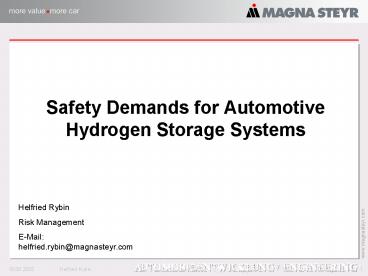Safety Demands for Automotive Hydrogen Storage Systems - PowerPoint PPT Presentation
1 / 15
Title:
Safety Demands for Automotive Hydrogen Storage Systems
Description:
... for automotive hydrogen storage systems ... Materials and accessories used shall be. compatible ... Fuel storage systems for vehicles require a fail-safe ... – PowerPoint PPT presentation
Number of Views:85
Avg rating:3.0/5.0
Title: Safety Demands for Automotive Hydrogen Storage Systems
1
Safety Demands for Automotive Hydrogen Storage
Systems
Helfried Rybin Risk Management E-Mail
helfried.rybin_at_magnasteyr.com
2
Content
- Introduction
- Demands for design and reliability
- Methods to minimize risks of design failures
- Validation
- Summary and outlook
3
Safety demands for automotive hydrogen storage
systems
- Future hydrogen powered vehicles operated by not
specially trained people - Fuel storage systems for vehicles require a
fail-safe design strategy - Materials and accessories used shall be
compatible with hydrogen
Source BMW Group / Munich, Germany
Source BMW Group / Munich, Germany
4
Fail-safe design strategy for liquid hydrogen
fuel tanks
- Design
- Redundant systems for safety, i.e. if one system
fails, another system has to secure the hydrogen
fuel tank - This philosophy is reflected by the following
regulation and standards - Draft UN ECE Regulation revision 14 and
14 add. 1 - keeping the probability of critical failures at
an acceptable level - risk of hydrogen powered vehicles may not exceed
the risk of conventional vehicles - Draft ISO 13985 Liquid Hydrogen Land vehicle
fuel tanks
5
Fail-safe design strategy for liquid hydrogen
fuel tanks
- Reliability
- System reliability is statistically proven over
the complete life cycle - Criteria for this reliability are reflected in
- IEC 61508 Functional safety of
electrical/electronic/programmable
electronic safety-related systems - about functional safety of safety-related
systems - looks at the whole safety life cycle
- classification into safety integrity levels
6
Fail-safe design strategy for liquid hydrogen
fuel tanks
Safety life cycle
7
Methods to minimize risks of failures in an early
design phase
- Failure mode and effect analysis (FMEA) ?
- ? is an instrument for avoiding risks and for
reducing cost for development and manufacturing
of products - ? researches the design for possible failures
due to initiate activities to avoid or reduce
the risk of this failure - ? is a method which promotes the
interdisciplinary team work at an early stage - ? delivers a documented expertise
8
Methods to minimize risks of failures in an early
design phase
- Lifetime estimation by finite element analysis
simulations - pressure due to vaporizing hydrogen
- expansion of materials during thermal cycling
- external loads due to mechanical vibrations
- fatigue oriented analysis of stress-time
histories - includes both physical tests and simulations
- illustrative animations of the deformation
behaviour and the resulting stresses - damage distribution of the cutting plane
Rain flow Analysis
9
Safety demands for automotive hydrogen storage
systems
10
Functional tests
Non-destructive functional testing on a liquid
hydrogen test bench
- The basic test program includes
- verification of valves and sensors at their
operating temperatures - leak rate measurement
- verification of the time for refuelling
- validation of the liquid level indication
- quality of the thermal insulation
11
Destructive tests
- Testing of the MLI for flammability
- Reason of this test
- Loss of vacuum causes an condensation of oxygen
? atmosphere with liquid oxygen in the vacuum
space - Risk of an explosion ? The MLI must not be
flammable to avoid a fire accident - Impact test
- mixture of liquid nitrogen and liquid oxygen
with minimum 50 liquid oxygen - The impact energy of 79 J/cm² must not cause
an ignition of the MLI - 20 samples are required
12
Destructive tests
Crash and skid test
Dynamic vibration test
Source BMW Group / Munich, Germany
- In order to examine the
- connection between body and liquid hydrogen
fuel tank - the suspension of the inner tank at high
external loads
- Statistic values for estimating the lifetime
behaviour - Inner tank
- at ambient temperature
- at cryogenic temperature (filled with liquid
hydrogen)
13
Destructive tests
Vacuum loss test
Bonfire test
Source Energie Technologie GmbH / Munich,
Germany
Source BAM / Berlin, Germany
- Proves the design of the pressure relief devices
in case of a degraded thermal insulation. - Following points are observed
- tank pressure and temperatures
- hydrogen blow-off behaviour
- hydrogen blow-off time
The average temperature in the space 10 mm below
the fuel tank shall be at least 863 K Thermal
autonomy of the liquid hydrogen fuel tank shall
be at least5 minutes Verification of the design
of the pressure relief devices
14
Safety demands for automotive hydrogen storage
systems
- Summary
- Fuel storage systems for vehicles require a
fail-safe design strategy - Methods to minimize risks of design failures in
an early design phase - FMEA
- Lifetime estimation by use of finite element
analysis - Non-destructive and destructive tests for
verification of the fuel system - Outlook
- to inspire public confidence in this new
technology - decrease costs by the standardization of legal
requirements for hydrogen internationally
15
Safety demands for automotive hydrogen storage
systems
Thank you for your attention
Helfried Rybin Risk Management E-Mail
helfried.rybin_at_magnasteyr.com































